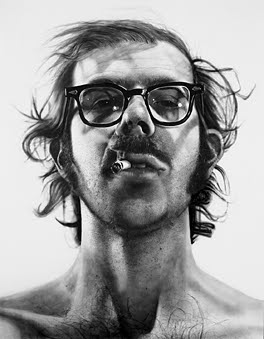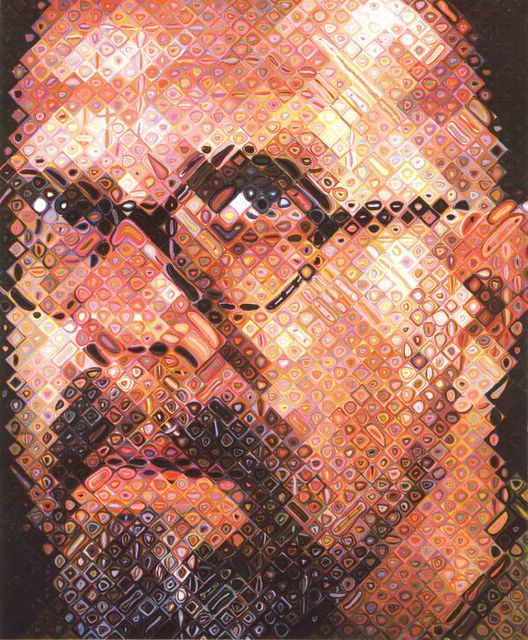Chuck Close
By: Natalie Ferguson
Chuck Close found his fame in the 1970s through his large-scaled portraitures that emerged from a movement called Photorealism. Having always been a fan or realism and portraiture, I aspire to be able to master the ability to mimic photographs effectively as well. Close was able to copy everything from the light effects to the glossiness of a photograph. In many ways, I think of Close as a modern day version of my favorite artist, Norman Rockwell. Although Close's work tends to focus only on the subject's less-animated face, each artist recreates people so well, it is as though we are staring into another person's eyes.
Big Self-Portrait (1967-68)
Acrylic on Canvas
107.5 x 83.5"
Clement Greenberg claimed that advanced artists cannot work in portraiture. Close proved this statement wrong, evident in his wildly successful work. The above Big Self-Portrait resembles a mug shot of Close himself. The black and white painting is easily mistaken as a photograph, seeing as Close mastered the camera's blurred effects in some areas of the painting. He was able to do this in many other of his portraits.
Phil (1969)
Synthetic polymer on canvas
108 x 84'
This portrait was of his friend Phillip Glass, who was a composer. In order to successfully copy the photograph, Close drew a grid over the picture. He used the grids as a roadmap for how to copy the drawing on a larger scale.He would also use a needle-nosed spray gun that would blow out paint to give his paintings the glossy picture effect. Pictured next to this portrait is Close himself.

Leslie
1973
Watercolor on canvas
Moving away from the black and white photographs, Leslie displays Close's ability to master mimicking color photographs as well. In both Leslie and Phil, it seems as though the picture was taken candidly, while they were listening to someone else think, or even just staring off into space.
Eventually, Close mastered photorealist portraiture and moved into a new stage of his art career. In 1988 he was paralyzed from the neck down after a seizure that caused a spinal artery collapse. He refers to this as "The Event". Facing his new disability, he started to explore the more systematic side of portraiture, and analyzed the underlining processes of a portrait/picture. He broke pictures into their more fundamental parts. In many ways, it reminds me of pixels in a television screen. He lost his precision, but was able to achieve the desired effects by holding a paintbrush between his teeth and painting.
65.5 x 54"
111-Color Silk, Screen
This new style has continued to make Close wildly popular. He has overcome so many limitations and has used his creativity to continue even in light of adversity.
Works Cited
“Chuck Close.” The Art Story. The Art Story Foundation, n.d. Web. 8 Oct. 2012.
<http://www.theartstory.org/artist-close-chuck.htm>.
“Chuck Close Gallery.” BlogSpot. N.p., n.d. Web. 8 Oct. 2012.
<http://chuckclosegallery.blogspot.com/>.
Danto, A. C. (2005, Chuck close. Smithsonian, 36, 106-108. Retrieved from
<http://search.proquest.com/docview/236855452?accountid=10598;
http://getitatduke.library.duke.edu/?ctx_ver=Z39.88-2004&ctx_enc=info:ofi/enc:UTF-8
&rfr_id=info:sid/ProQ%3Apqrl&rft_val_fmt=info:ofi/fmt:kev:mtx:journal&rft
.genre=article&rft.jtitle=Smithsonian&rft.atitle=Chuck+Close&rft.au=
Danto%2C+Arthur+C&rft.aulast=Danto&rft.aufirst=Arthur&rft.date=2005-11-
01&rft.volume=36&rft.issue=8&rft.spage=106&rft.isbn=&rft.btitle=
&rft.title=Smithsonian&rft.issn=00377333>.
Storr, Robert. Chuck Close. New York: MoMA, 1998. Print.



No comments:
Post a Comment